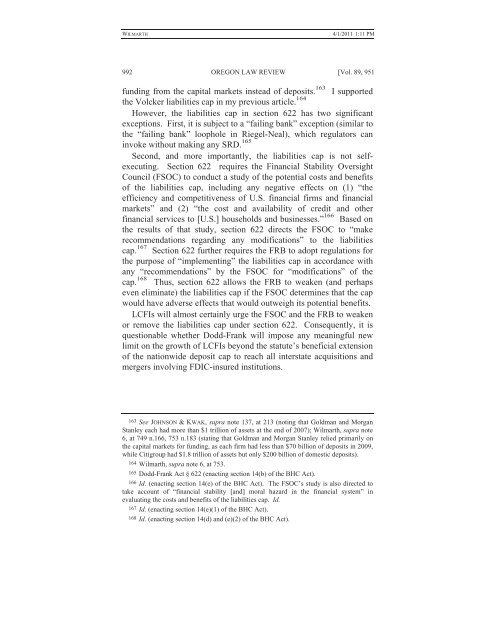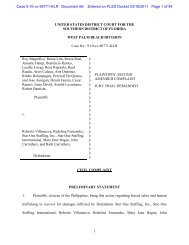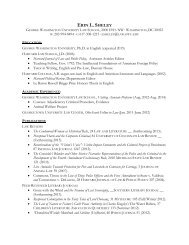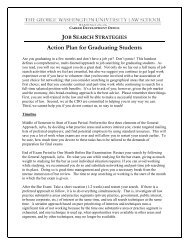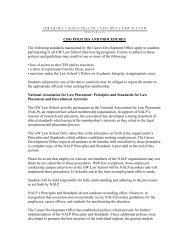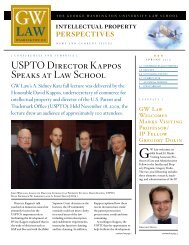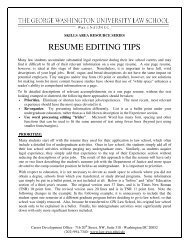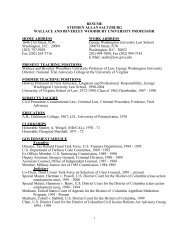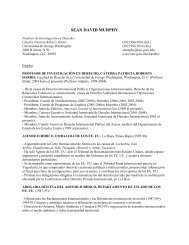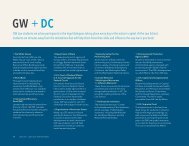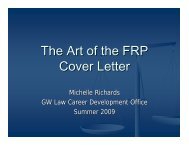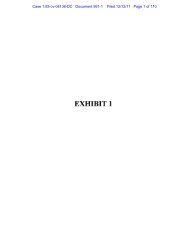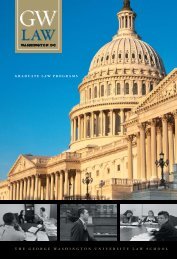CLE Materials for Panel #1 - George Washington University Law ...
CLE Materials for Panel #1 - George Washington University Law ...
CLE Materials for Panel #1 - George Washington University Law ...
You also want an ePaper? Increase the reach of your titles
YUMPU automatically turns print PDFs into web optimized ePapers that Google loves.
WILMARTH<br />
4/1/2011 1:11 PM<br />
992 OREGON LAW REVIEW [Vol. 89, 951<br />
funding from the capital markets instead of deposits. 163 I supported<br />
the Volcker liabilities cap in my previous article. 164<br />
However, the liabilities cap in section 622 has two significant<br />
exceptions. First, it is subject to a “failing bank” exception (similar to<br />
the “failing bank” loophole in Riegel-Neal), which regulators can<br />
invoke without making any SRD. 165<br />
Second, and more importantly, the liabilities cap is not selfexecuting.<br />
Section 622 requires the Financial Stability Oversight<br />
Council (FSOC) to conduct a study of the potential costs and benefits<br />
of the liabilities cap, including any negative effects on (1) “the<br />
efficiency and competitiveness of U.S. financial firms and financial<br />
markets” and (2) “the cost and availability of credit and other<br />
financial services to [U.S.] households and businesses.” 166 Based on<br />
the results of that study, section 622 directs the FSOC to “make<br />
recommendations regarding any modifications” to the liabilities<br />
cap. 167 Section 622 further requires the FRB to adopt regulations <strong>for</strong><br />
the purpose of “implementing” the liabilities cap in accordance with<br />
any “recommendations” by the FSOC <strong>for</strong> “modifications” of the<br />
cap. 168 Thus, section 622 allows the FRB to weaken (and perhaps<br />
even eliminate) the liabilities cap if the FSOC determines that the cap<br />
would have adverse effects that would outweigh its potential benefits.<br />
LCFIs will almost certainly urge the FSOC and the FRB to weaken<br />
or remove the liabilities cap under section 622. Consequently, it is<br />
questionable whether Dodd-Frank will impose any meaningful new<br />
limit on the growth of LCFIs beyond the statute’s beneficial extension<br />
of the nationwide deposit cap to reach all interstate acquisitions and<br />
mergers involving FDIC-insured institutions.<br />
163 See JOHNSON &KWAK, supra note 137, at 213 (noting that Goldman and Morgan<br />
Stanley each had more than $1 trillion of assets at the end of 2007); Wilmarth, supra note<br />
6, at 749 n.166, 753 n.183 (stating that Goldman and Morgan Stanley relied primarily on<br />
the capital markets <strong>for</strong> funding, as each firm had less than $70 billion of deposits in 2009,<br />
while Citigroup had $1.8 trillion of assets but only $200 billion of domestic deposits).<br />
164 Wilmarth, supra note 6, at 753.<br />
165 Dodd-Frank Act § 622 (enacting section 14(b) of the BHC Act).<br />
166 Id. (enacting section 14(e) of the BHC Act). The FSOC’s study is also directed to<br />
take account of “financial stability [and] moral hazard in the financial system” in<br />
evaluating the costs and benefits of the liabilities cap. Id.<br />
167 Id. (enacting section 14(e)(1) of the BHC Act).<br />
168 Id. (enacting section 14(d) and (e)(2) of the BHC Act).


